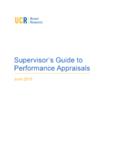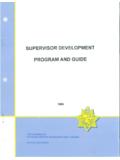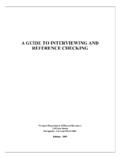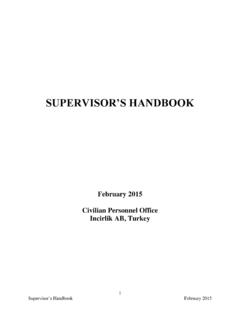Transcription of Supervisor’s Guide to Performance Appraisals
1 supervisor 's Guide to Performance Appraisals Table of Contents Introduction ..3. Benefits of Productive Performance Meetings ..3. Performance Goals Help Employees ..3. Performance Goals Help Supervisors ..4. Preparing the Employee and Scheduling the Performance Meeting ..4. Completing the Annual Performance Summary Form ..4. Conducting the Performance Meeting ..7. Helping Employees Set Career Guidelines for Handling a Meeting with a Poor Discussing Employee Attitude Addressing Emotional Situations ..11. Crying ..11. Shouting ..12. Walking Away ..12. Becoming Quick to Agree ..12. Preparing for Next Year's Performance Documenting Job Performance ..13. Coaching Employee Performance ..14. Planning and Preparation ..14. Conducting a Coaching Session.
2 15. Action-planning and How Human Resource Services Can Assist ..17. Page | 2. supervisor 's Guide to Performance Appraisals Introduction The following guidelines are designed to assist you in conducting Performance Appraisals of employees who report to you. It is very important to assess job-related Performance and not personality unless it relates directly to the employee's Performance . Please keep in mind that you are a role model for those who report to you. There is no substitute for courtesy, sensitivity, and a common sense approach to the Performance appraisal process. This Guide has been developed in conjunction with the revision of the annual Appraisals forms used for Merit (AFSCME) employee by the 2000 Merit Evaluation Task Force, including task force members and employees from AFSCME, the Department of Residence, Library, Physical Plant, Print Services, and Human Resource Services.
3 In certain instances, reference is made to the actual evaluation forms used for Merit employees, including the Annual Performance Summary and the Discussion Guide for Annual Performance Summary. This Guide may also be used as a reference tool by supervisors who conduct Performance Appraisals of other employee classifications, such as Professional & Scientific. Where reference is made to the specific Merit evaluation forms, please substitute the forms that you have been provided for use. Benefits of Productive Performance Meetings A productive Performance meeting serves as a collaborative planning session during which both the supervisor and the employee can take an in-depth look at past and current performances and can together set new goals and objectives for the coming year.
4 The Performance meeting helps the supervisor and employee establish a clearer understanding of the employee's job duties, responsibilities, and priorities. It also provides an opportunity for the supervisor to coach the employee on how to become more proficient and productive. Establishing Performance goals provides direction and helps the employee and supervisor in the following ways: Performance Goals Help Employees: Find out how they are doing. Know what is expected of them. Take responsibility for their Performance . Learn their Performance strengths and weaknesses. See where their goals support organizational goals. Direct efforts where they can do the most for their own careers and for group and organizational success. Page | 3. Feel that they are taken seriously as individuals and that the supervisor is truly concerned about their needs and goals.
5 Performance Goals Help Supervisors: Develop an objective means for evaluation employees. Tie individual tasks, goals, and direction to group and organizational goals. Work with employees on career development plans and paths. Identify where individuals need coaching and training. Provide recognition and motivation to employees. Document an employee's progress towards reaching goals. For further information regarding the Performance review process, you may borrow training videos from Human Resource Services by contacting the receptionist at 319-273-2422. Preparing the Employee and Scheduling the Performance Meeting Advise the employee of the Performance meeting at least one week in advance. Ask the employee to complete the optional Discussion Guide for Annual Performance Summary to bring to the meeting.
6 The purpose of the Discussion Guide for Annual Performance Summary is to encourage communication and to provide discussion points between the employee and supervisor during the Performance meeting. The Discussion Guide for Annual Performance Summary can also be obtained from UNI's Forms Repository located at Also, let the employee know that you intend to discuss his/her personal career objectives at the meeting. If you have done this in the past, you may want to provide the employee with a written list of goals that you both set during the last Performance meeting. Ask the employee to think about what progress has been made toward those goals and what goals he/she would adjust the priorities that have been set. The date and time that you schedule the meeting for should be mutually convenient to you and the employee.
7 Set aside at least one hour with no ringing telephones or interruptions and find a private room for the meeting. When scheduling consecutive Performance meetings, ensure there is enough time between them so you do not rush the appraisal process. Completing the Annual Performance Summary Form The better prepared you are for the Performance appraisal meeting, the more productive your discussion will be. It all starts with your completion of the Annual Performance Summary form- the more time and effort you put into completing it, the better prepared you will be for the Page | 4. supervisor 's Guide to Performance Appraisals appraisal meeting. Before sitting down to complete the Annual Performance Summary for an employee, gather the following information and documents for your review and reference : Employee's job description.
8 Date employee began present position;. Length of time the employee has reported to you;. Record of employee's attendance during past year;. Your notes or journal regarding the employee's Performance during the past year;. Current projects the employee is working on and employee's progress;. Examples of work problems you want to discuss;. Examples of employee's work over the past year and recent work;. How employee relates to co-workers, internal and external customers, and others;. Level of employee's technical skills;. Employee's educational background and experience;. List of job and career objectives drawn up during past Performance review;. List of training and development courses attended by employee during past year;. List of available training courses appropriate for employee for upcoming year.
9 When completing the evaluation form, consider whether the employee met his/her goals for the period. If not, were there any outside circumstances (new orders, staff cuts, equipment problems) that limited the employee's ability to meet goals? Did you provide the employee with feedback on progress toward goals during the year? Do you have records of specific examples of successes, improvements, or weaknesses? Do your examples include feedback form internal and external customers, other supervisors, etc? When rating an employee on different factors, base the ratings on how well the employee performed his/her job. Be careful of dramatic declines such as exceeds expectations to needs improvement. The supervisor must address all needs improvement ratings as well as other issue, in the supportive details or comments section of the form.
10 All comments made should be meaningful and consistent with Performance rankings. It is important to be aware of, and to guard against, the following common tendencies: Page | 5. Rating Tendency Explanation Halo Effect A tendency to rate high on one quality which may influence a higher than deserved rating on another quality, such as rating someone high because you personally like him/her. Opposite of Halo A rating of unsatisfactory on one quality may influence a lower than deserved Effect rating elsewhere, such as rating someone low because you do not like his/her personal style. Central Tendency Rating Performance as average or around the midpoint. This is the most common and serious of the rater tendencies. Recent Behavior Basing the rating on recent Performance on a project rather than overall Performance throughout the past year.













